Common Snakes of Ohio: There are over 25 different snake species found in Ohio and out of those, three of them are said to be venomous. With steep valleys, rugged hills, big lakes, long rivers, isolated islands and drainage basins, the state has plenty to offer the average snake looking to snack on water-dwelling creatures such as frogs, toads and even newts and salamanders.
Venomous snakes of Ohio: There are only three venomous snakes and they are:
Timber Rattlesnake
Also known as the timber rattler, this snake usually measures in between 35 and 55 inches in length, a yellow or brown coloration with black or brown bands going from one side to the other across the back.
Eastern Massassauga Rattlesnake
The second venomous snake of Ohio is also a rattlesnake but this time, the Eastern Massassauga Rattlesnake, a slightly smaller species measuring just 20-30 inches in length. A darker color than the timber rattlesnake, this one is usually a brown-gray color with darker almost bow-shaped patches running down the length of its back. You’ll find this snake commonly in the northern parts of the state, and also along the color, glaciated areas to the west.
Northern Copperhead
Around the same size as the Massassauga rattlesnake, the northern copperhead (25 - 36 inches) is a pit viper that is often referred to as the copperhead snake.
Call the below number for snake removal help in your area:
Akron: 330-615-1600
Canton: 440-527-6300
Cincinnati: 513-298-5400
Cleveland: 440-527-6300
Columbus: 614-362-0905
Dayton: 937-790-4057
Toledo: 419-775-4945
Among the most common snakes of Ohio, you will find:
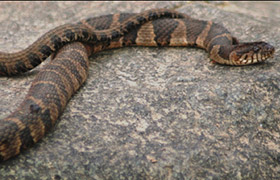
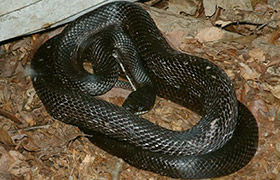
The snake sometimes looks a little like the copperhead snake to some people but the two shouldn’t be confused - the rat snake is not venomous whereas the copperhead is. As youngsters, you may spot rat snakes around suburban areas - outbuildings, garages and sheds tend to be quite popular as well as getting inside residential properties too.
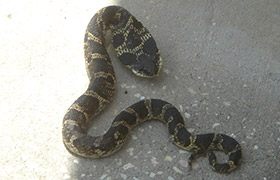
A relatively small snake, the eastern hognose only grows to about 20-30 inches in length, and you’ll find it in most areas of Ohio, most prolifically in the northwest, central and southern regions.
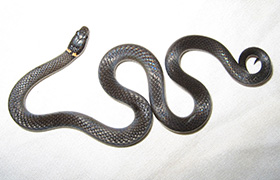
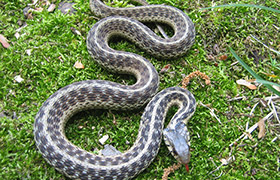
Found mostly in the north-west regions, Butler’s garter snakes (and garter snakes in general) live in moist and quite open, grassy areas such as marshes, wet prairies, and meadows, but will happily move into more suburban areas with vacant grassy lots or unkempt gardens. Their main source of food is earthworms, often bringing them to back yards, but they’ll also eat frogs, toads and salamanders. Butler’s garter snake is classed as an endangered species in the state of Indiana.
You may also see the Short-Headed Garter Snake in Ohio.
Queensnake
Another of the relatively small common snakes of Ohio, the queensnake only grows to a maximum length of around 25 inches and is a pretty uninteresting looking reptile, usually a black, dark brown or greens-brown one-tone color. Located across the whole of Ohio, you might spot this snake in your back yard particularly in long grasses where it is very well camouflaged.
Lake Erie Watersnake
Similar in size to the common watersnake is the Lake Erie watersnake, a slightly thicker species with more of a green tinge than a brown one. You may even notice tinges of pink in the lengthways running patterns and formations. As the name suggests, this snake is generally only found in the islands that dot around Lake Erie. Other common snakes of Ohio include the Copper Belly Watersnake, a black or dark brown / black snake with a red or slightly orange belly commonly found around the Williams County area.
Kirtland’s Snake
A much smaller snake, the Kirkland’s snake is only about 15 inches long and has large spot-like markings, often with bright colors on the underbelly such as bright orange. Very common in places such as Hamilton and Lucas, it’s a pretty common snake that can be found across most of the state.
Northern Red-Belly
Another teeny-tiny snake only measuring up to ten inches, the grey / brown snake with four vertically running stripes really is nothing to worry about, more often than not missed because of its small size and speed.
Wormsnake
You’ll find the Eastern Wormsnake and the Midwestern Wormsnake in Ohio, more tiny snakes that only grow to about 10 or 11 inches, quite dark-colored snakes although the eastern variety tends to be more pinky-red than it’s midwestern cousin. You’ll find these in the more southerly places of the state.
Brownsnake
You’ll find the Midland Brownsnake and the Northern Brownsnake in Ohio, easily distinguishable from their brown and dark marks situated on the sides of the snake’s head. Growing to around 13 inches maximum, these non-venomous snakes are harmless to humans when left alone.
Eastern Smooth Earthsnake
Another very small snake, this species only grows to about 10 or 11 inches and is easily missed as it prefers to hide beneath loose leaves and soil. You may even notice these in your back yard, hidden in the flower beds. Their food source includes bugs, beetles and earthworms, all of which are commonly found in your back yard. There are a number of other snakes which are often found across other states too, and these include: